
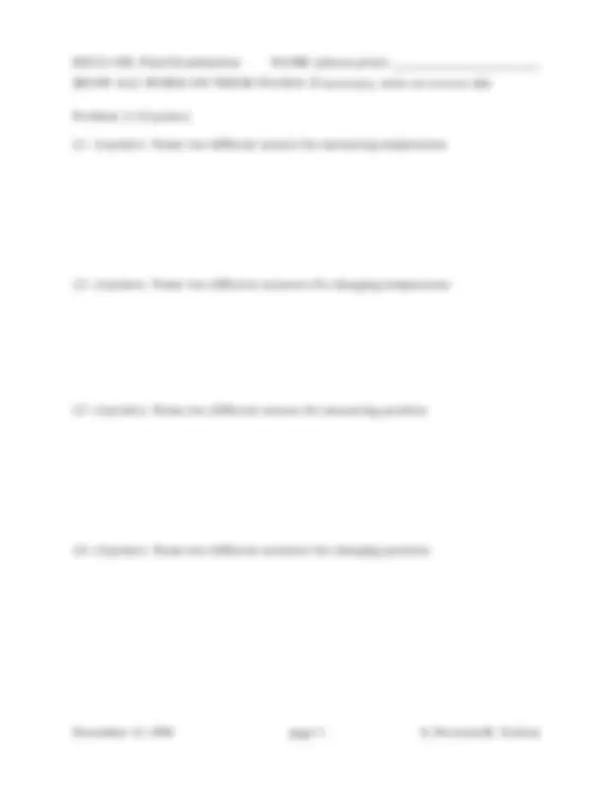
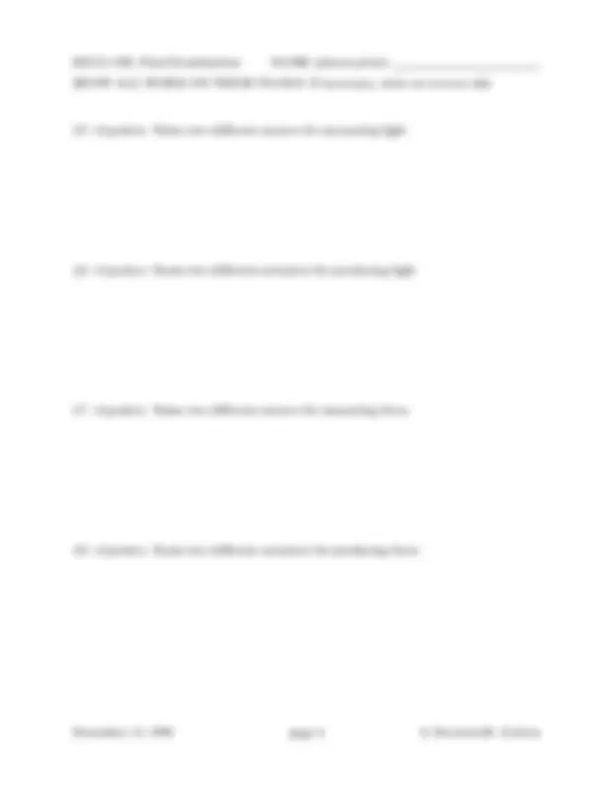
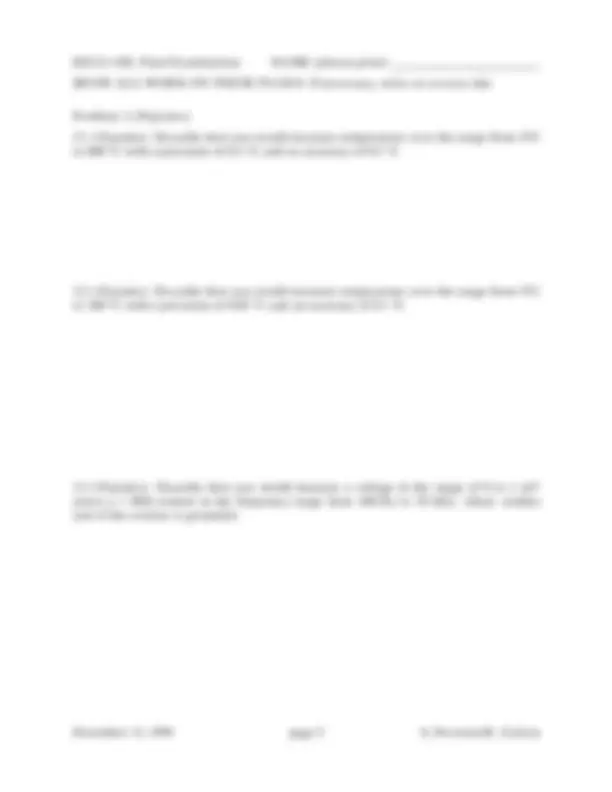
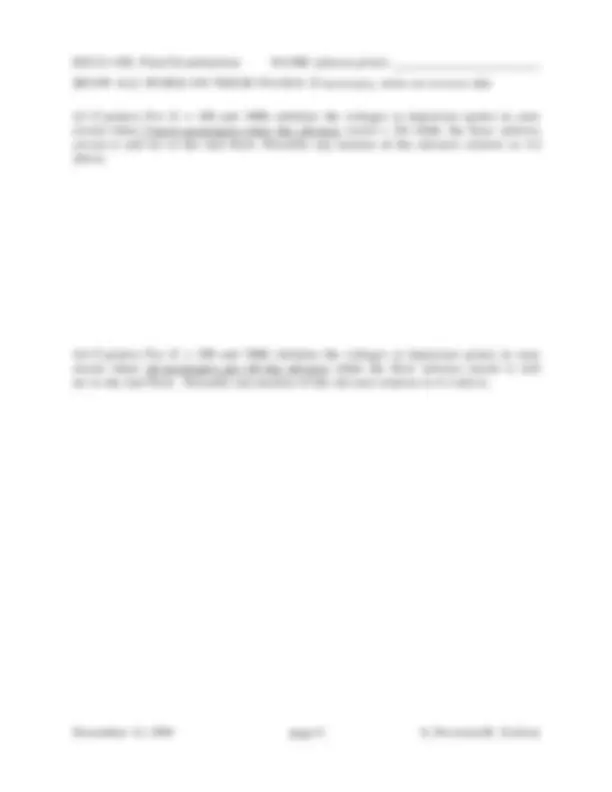
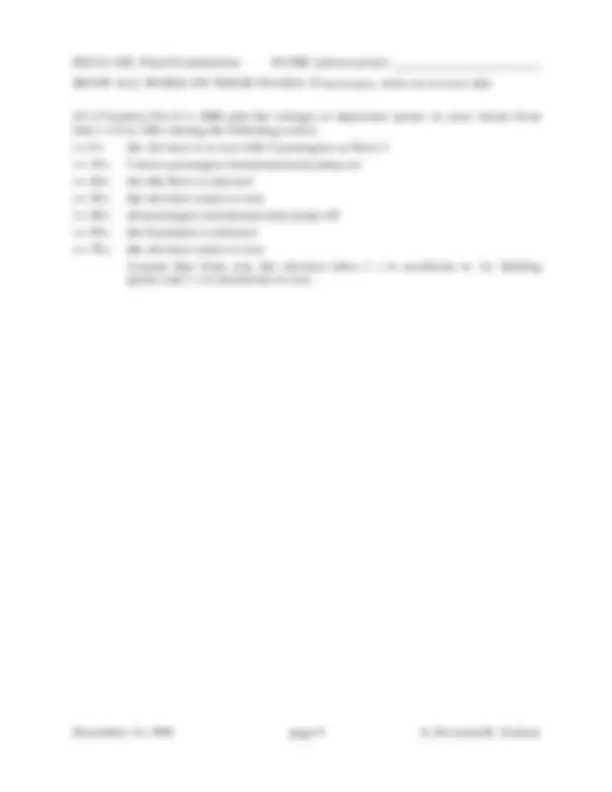
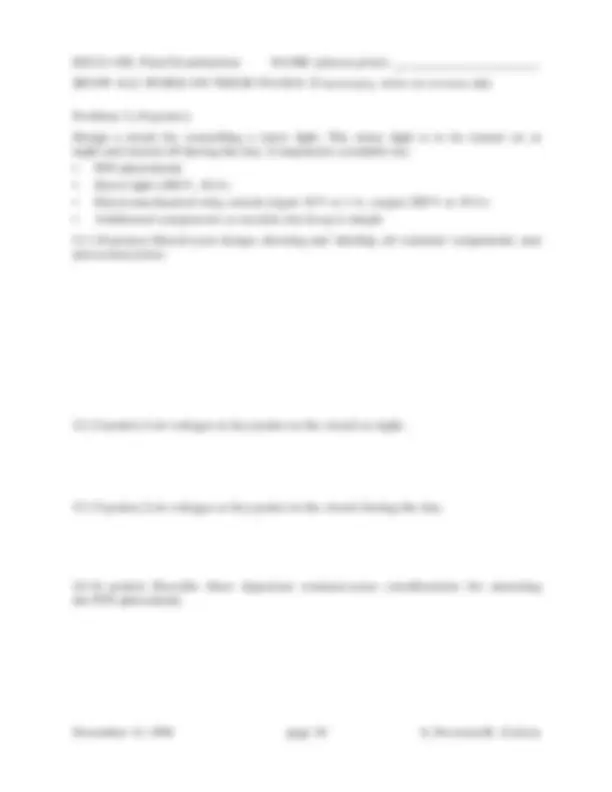
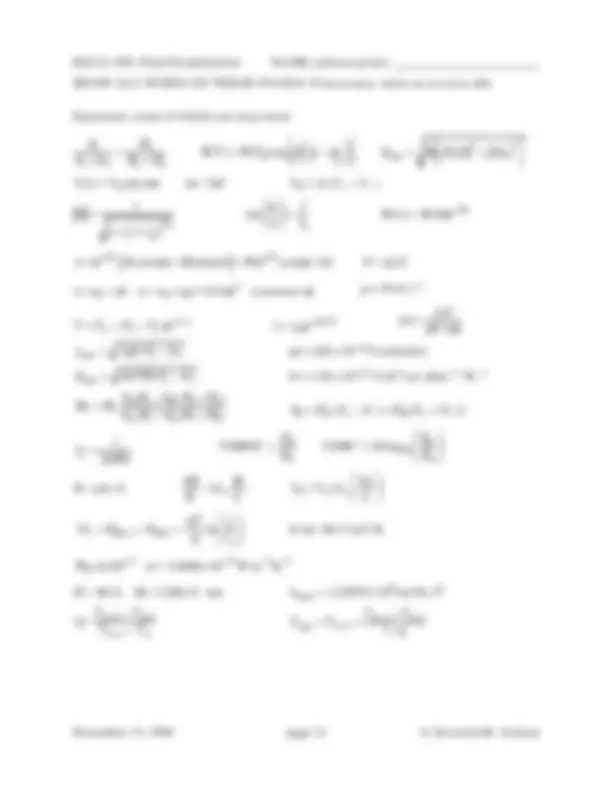
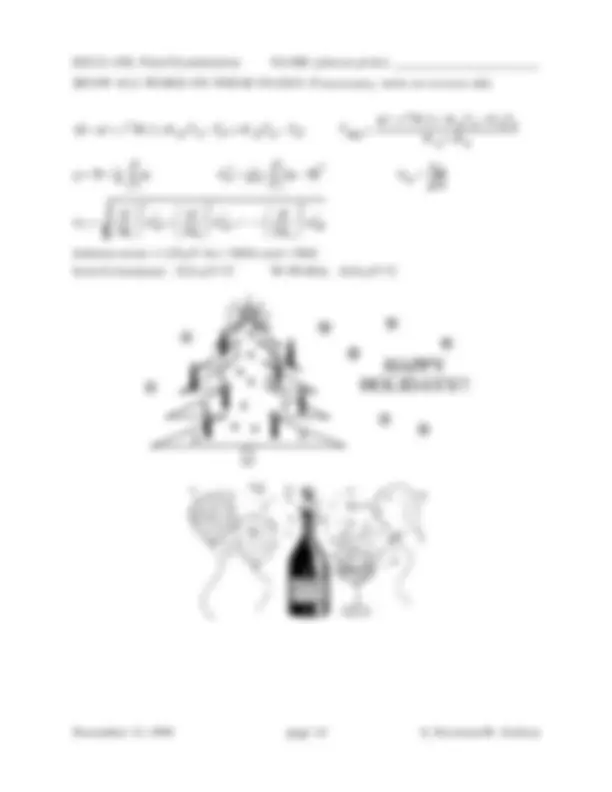


Study with the several resources on Docsity

Earn points by helping other students or get them with a premium plan


Prepare for your exams
Study with the several resources on Docsity

Earn points to download
Earn points by helping other students or get them with a premium plan
Community
Ask the community for help and clear up your study doubts
Discover the best universities in your country according to Docsity users
Free resources
Download our free guides on studying techniques, anxiety management strategies, and thesis advice from Docsity tutors
The final examination for the eecs 145l: electronic transducer laboratory course offered at the university of california, berkeley. The exam covers various topics related to sensors, actuators, temperature measurement, voltage measurement, and circuit design. Students are required to answer multiple-choice and problem-solving questions related to these topics.
Typology: Exams
1 / 14

This page cannot be seen from the preview
Don't miss anything!









SHOW ALL WORK ON THESE PAGES- If necessary, write on reverse side
College of Engineering Department of Electrical Engineering and Computer Sciences
EECS 145L: Electronic Transducer Laboratory
FINAL EXAMINATION December 13, 1994 5:00 - 8:00 PM
You have three hours to work on the exam, which is to be taken closed book. Calculators are OK, but not needed. Total points = 200 out of 1000 for the course.
1 ______________ (30 max) 2 ______________ (32 max) 3 ______________ (30 max)
4 ______________ (50 max) 5 ______________ (34 max) 6 ______________ (24 max)
TOTAL _____________ (200 max)
LAB TOTAL =_______ (500 max)
LAB TOTAL
LAB PARTICIPATION
MID-TERM #
MID-TERM #
FINAL EXAM
TOTAL COURSE GRADE
(500 max)
(100 max)
(100 max)
(100 max)
(200 max)
(1000 max)
SHOW ALL WORK ON THESE PAGES- If necessary, write on reverse side
Problem 1 (30 points)
Give definitions (20 words or less) for the following terms:
1.1 (5 points) Accuracy of a sensor
1.2 (5 points) Precision of a sensor
1.3 (5 points) Seebeck emf
1.4 (5 points) Angle sensor (resistor)
1.5 (5 points) PIN photodiode
1.6 (5 points) Photovoltaic mode of a photodiode
SHOW ALL WORK ON THESE PAGES- If necessary, write on reverse side
2.5 (4 points) Name two different sensors for measuring light
2.6 (4 points) Name two different actuators for producing light
2.7 (4 points) Name two different sensors for measuring force
2.8 (4 points) Name two different actuators for producing force
SHOW ALL WORK ON THESE PAGES- If necessary, write on reverse side
Problem 3 (30 points)
3.1 (10 points) Describe how you would measure temperature over the range from 0°C to 600 °C with a precision of 0.2 °C and an accuracy of 0.5 °C
3.2 (10 points) Describe how you would measure temperature over the range from 0°C to 100 °C with a precision of 0.05 °C and an accuracy of 0.1 °C
3.3 (10 points) Describe how you would measure a voltage in the range of 0 to 1 mV across a 1 MΩ resistor in the frequency range from 100 Hz to 10 kHz, where neither end of the resistor is grounded.
SHOW ALL WORK ON THESE PAGES- If necessary, write on reverse side
4.1 (20 points) Sketch your circuit design, including the floor selector circuit, the motor power converter, the elevator motor, the difference amplifier, and any other components that may be necessary.
4.2 (5 points) For G = 100 and 1000, tabulate the voltages at important points in your circuit when the elevator has 5 passengers, the 2nd floor has been selected, and the elevator has come to rest.
SHOW ALL WORK ON THESE PAGES- If necessary, write on reverse side
4.3 (5 points) For G = 100 and 1000, tabulate the voltages at important points in your circuit when 5 more passengers enter the elevator (total = 10) while the floor selector circuit is still set to the 2nd floor. Describe any motion of the elevator relative to 4. above.
4.4 (5 points) For G = 100 and 1000, tabulate the voltages at important points in your circuit when all passengers get off the elevator while the floor selector circuit is still set to the 2nd floor. Describe any motion of the elevator relative to 4.3 above.
SHOW ALL WORK ON THESE PAGES- If necessary, write on reverse side
Problem 5 (34 points)
Design a circuit for controlling a street light. The street light is to be turned on at night and turned off during the day. Components available are:
5.1 (18 points) Sketch your design, showing and labeling all essential components and interconnections.
5.2 (5 points) List voltages at key points in the circuit at night.
5.3 (5 points) List voltages at key points in the circuit during the day.
5.4 (6 points) Describe three important common-sense considerations for mounting the PIN photodiode.
SHOW ALL WORK ON THESE PAGES- If necessary, write on reverse side
Problem 6 (24 points)
You have just been hired to design a sensor for a new class of icebreaker ship. These ships are used to smash their way through sheets of floating ice, either to get to a destination, or to clear a passage for other ships. The hull (outer structural surface) is very thick and strong, but the ship’s engines are powerful and it is possible to damage or destroy the hull by driving it against large floating slabs of thick ice. The plan is to provide the captain of the ship with a continuous monitor of the shear on the hull at the water line. The shear is the difference between the strain a few feet below the water line (where the ice is pushing against the moving ship) and the strain a few feet above the water line (where there is no ice). When the ice becomes thicker or the slabs become larger, the engine speed can be reduced to avoid damage to the hull.
Bow
Stern
Screw
Waterline Ice
Bridge
Design a system that
Assume that the temperature of ice-laden sea water is constant (28°C) so you do not have to compensate for changes in temperature.
SHOW ALL WORK ON THESE PAGES- If necessary, write on reverse side
Equations, some of which you may need:
V 1 V 1 + V 2
R ( T ) = R ( T 0 )exp β (^) T^1 − (^) T^1 0
2
V(t) = V 0 sin(ωt) ω = 2 πf V 0 = A(V+ − V− )
2 n
tan
φ n
f fc
N ( x ) = N (0) e − x μ
v = v 0 + a t x = x 0 + v 0 t + 0.5 at^2 (constant a ) g = 10 m s–
T = T 2 − ( T 2 − T 1 ) e − t^ /^ τ^ I = I 0 e − kLC^ ∆ x^ =^
dV / dx
I rms = 2 qI ( F 2 − F 1 ) q = 1.60 x 10–19^ Coulombs
V rms = 4 kTR ( F 2 − F 1 ) k = 1.38 x 10–23^ Volt^2 sec ohm–1^ °K–
Vb R 1 − V 0 ( R 1 + R 2 ) Vb R 2 + V 0 ( R 1 + R 2 ) V^0 =^ G ±( V +^ −^ V −^ )^ +^ Gc^ ( V +^ +^ V −)
fc =
2 π RC
Gc
“CMR”= 20 log 10
Gc
R = ρA / L
= Gs
V 0 = Vb Gs
kT q
ln
k^ / q^ =^ 86.17^ μV/ K
PR =σ AT^4 σ = 5.6696 × 10 −^8 W m−^2 K 4
E = hc /λ hc = 1240 eV ⋅nm λmax = (2.8978 × 106 nm K) / T
η=
Tn + 2 − Tn + 1 Tn + 1 − Tn
T equ = Tn + 1 +
Tn + 2 − Tn + 1 1 −η
SHOW ALL WORK ON THESE PAGES- If necessary, write on reverse side
Q = π I + I^2 R / 2 + K (^) p ( Ts − T 0 ) + K (^) a ( Ta − T 0 ) Tequ =
π I + I^2 R /2 + K (^) pTs + K (^) aTa K (^) p + Ka
μ ≈ a = (^) m^1 ai i = 1
m
m − 1 (^ ai^ −^ a )
2 i = 1
m
σ a m
σ (^) f =
∂ f ∂ a 1
2 σ a^21 +
∂ f ∂ a 2
2 σ a^2 2 + +
∂ f ∂ an
2 σ an^2
Johnson noise = 129 μV for 1 MHz and 1 MΩ
Iron+Constantan - 52.6 μV/°C W+W(Rh) - 16.0 μV/°C
b
b b
b
a
a a
a HAPPY HOLIDAYS!!
d
d
e
e
f
f
d
e
b a
a
b
b
b
b